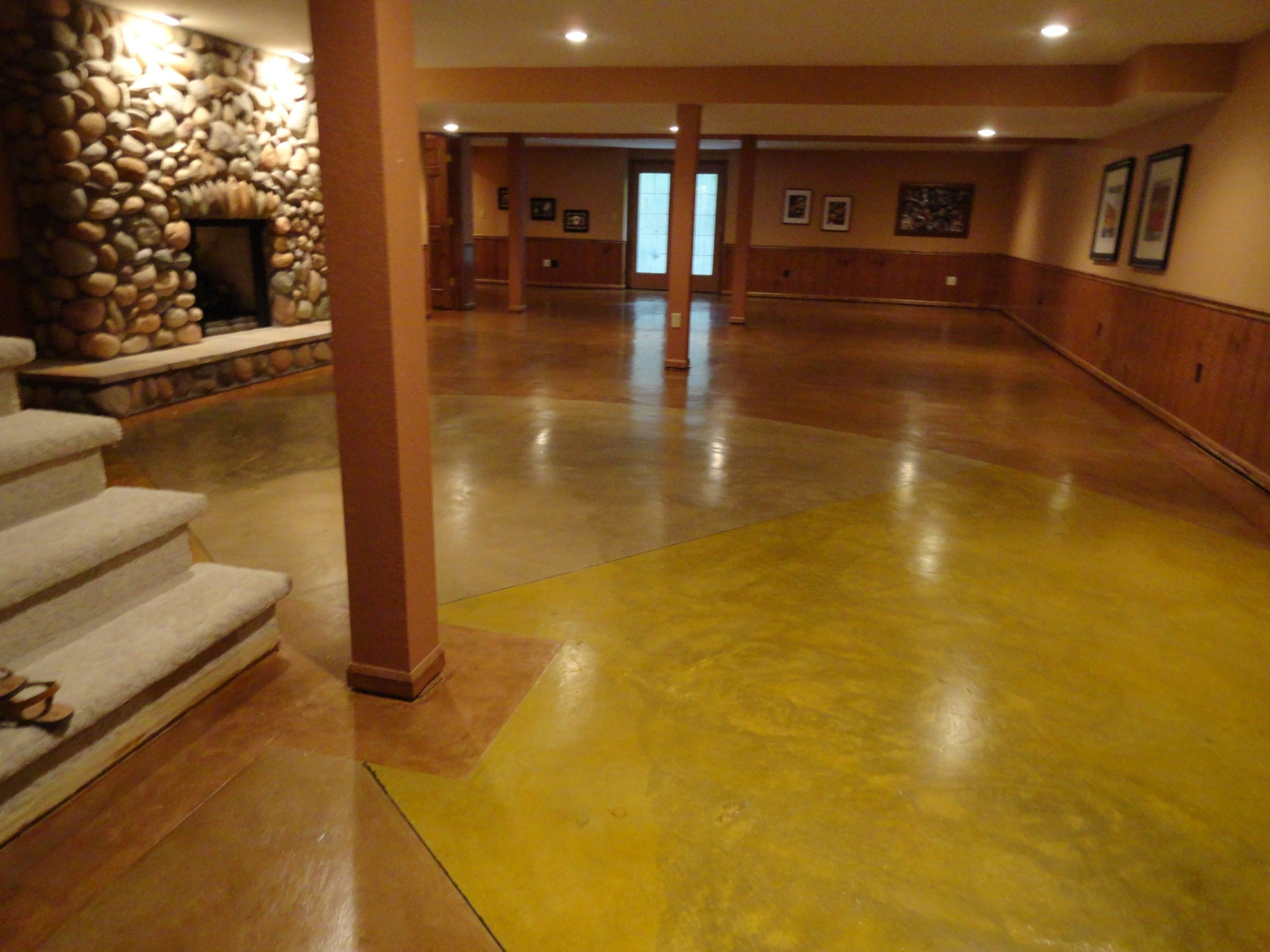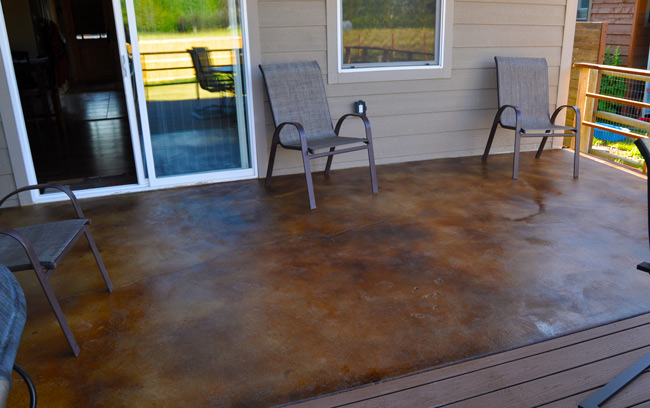Reasons a stained concrete company can transform your property
Understanding the Various Types of Stained Concrete for Your Following Job
Stained concrete offers different alternatives that satisfy different visual and practical requirements. Each kind provides distinctive features that affect the final appearance and longevity of the surface. Comprehending these distinctions is crucial for anyone planning a project. From rich, chain reactions of acid-based stains to the dynamic harmony of solid color stains, the options can considerably impact the outcome. What variables should one think about when picking the ideal stain for their certain needs?
Introduction of Stained Concrete
Stained concrete functions as a versatile flooring choice that can improve the visual allure of different spaces. This technique includes using a coloring agent to the surface of existing concrete, permitting a broad range of style opportunities. Stained concrete is prominent in both household and industrial environments, offering a durable and low-maintenance remedy that can imitate the appearance of natural products like stone or ceramic tile.
The discoloration process can be carried out using water-based or solvent-based products, each giving distinctive visual results. The final appearance is affected by factors such as the original concrete surface area, the kind of tarnish used, and the application approach. Stained concrete not only improves interiors and exteriors but additionally promotes sustainability by revitalizing existing concrete frameworks. Therefore, it has obtained traction among home owners and designers looking for both functionality and style in their floor covering options.
Acid-Based Stains: Qualities and Advantages

One-of-a-kind Color Variants
Concrete surfaces can change dramatically with the application of acid-based stains, which use an abundant scheme of distinct shade variations. These stains permeate the concrete, responding chemically to create dynamic planet tones that vary from deep browns and reds to soft eco-friendlies and blues. The resulting tones are commonly variegated, producing an all-natural, marble-like appearance that improves the concrete's personality. Each application returns distinct outcomes because of variations in the concrete's composition and the staining technique used, making every task one-of-a-kind. In addition, acid-based stains can be split or incorporated with other techniques to produce customized styles, allowing for individual expression. This adaptability makes acid-based stains a popular choice for both residential and commercial applications.
Chain Reaction Clarified
While several variables add to the performance of acid-based stains, the underlying chemical responses play an essential duty in their special attributes and benefits. These stains mostly contain water, acid, and metal salts. When related to concrete, the acid reacts with the calcium hydroxide in the cement, creating a chemical makeover that results in irreversible color adjustments. The metal salts pass through the surface and bond with the concrete, enabling a variety of shades and tones. This response not just enhances aesthetic allure but likewise provides durability, making the color resistant to fading and wear. Furthermore, acid-based stains can produce a variegated surface that mimics all-natural rock, additional improving their appeal for attractive concrete applications.
Surface Area Prep Work Importance
Accomplishing suitable results with acid-based stains depends upon thorough surface area prep work. This vital action assurances that the concrete surface is clean, without contaminants, and effectively profiled for excellent tarnish absorption. Any kind of existing sealants, dirt, or oils can impede the chain reaction that produces the desired shade and surface, bring about irregular or patchy outcomes.
Prior to using the stain, the concrete must be mechanically cleansed or pressure cleaned, complied with by a comprehensive assessment for cracks or imperfections that might call for repair service. In addition, verifying the surface is properly dried out will certainly boost discolor adherence. By focusing on these primary measures, the long life and vibrancy of acid-based stains can be substantially enhanced, resulting in a more visually pleasing and long lasting coating.
Water-Based Stains: Features and Advantages

Water-based stains penetrate the concrete, supplying an extra transparent finish that highlights the natural appearance and variants of the surface area below. They are available in a vast array of shades, enabling for official website imaginative flexibility in layout. In addition, water-based stains are much easier to cleanse up, calling for just water and soap, which simplifies the application process.
Their fast drying out time boosts performance, making them a useful choice for both do it yourself enthusiasts and professionals. Overall, water-based stains give an enticing combination of aesthetic adaptability and straightforward homes, making them a prominent option for concrete enhancement projects.
Solid Color Stains: Lively Choices for a Vibrant Appearance
Strong color stains offer an effective solution for those seeking to create a strong and vibrant visual on concrete surface areas. These stains provide an uniform pigmentation that can substantially boost the visual allure of floors, patio areas, and driveways. Offered in a this website broad range of shades, strong color stains permit innovative expression, satisfying various design preferences.
One of the key benefits of solid color stains is their capacity to hide flaws, supplying a fresh and refined look to maturing concrete - local stained concrete. In addition, their formula usually consists of UV-resistant residential properties, making sure longevity and shade retention even in rough weather condition conditions
Application is straightforward, calling for very little preparation of the concrete surface area. When applied, strong color stains can be secured for included defense and sheen, more elevating their visual quality. With their lively alternatives, solid shade stains are an exceptional choice for those intending for an impactful and cohesive style.
Semi-Transparent Stains: Accomplishing Depth and Dimension
Semi-transparent stains supply a special method to enhancing concrete surfaces by offering deepness and measurement through numerous color choices. Understanding the application methods is necessary for attaining the desired impact, while appropriate upkeep practices ensure durability. This area will certainly explore these crucial aspects to make the most of the advantages of semi-transparent discoloration.
Color Options Available
A wide array of color choices exists for semi-transparent stains, permitting homeowners and designers to boost the all-natural charm of concrete surfaces. These stains can be found in an array of shades, from natural tones like browns and terracottas to dynamic shades such as blues and environment-friendlies. The semi-transparent nature of these stains enables the underlying concrete to show through, creating an unique deepness and measurement that can match different design visual appeals. Furthermore, integrating various shades can generate custom shades, making it possible for a tailored try to find each job. This versatility makes semi-transparent stains a prominent option for both exterior and interior applications, as they can harmonize with surrounding components while adding aesthetic interest to plain concrete.
Application Techniques Explained
To achieve the desired deepness and dimension with semi-transparent stains, proper application techniques are important. Surface area preparation is vital; the concrete needs to be clean and complimentary of any kind of impurities. This typically involves power washing and fixing any type of fractures. Next, picking the right applicator, such as a sprayer, roller, or brush, can affect the final look. Sprayers permit a much more even application, while rollers can help achieve appearance. you can try here It is necessary to apply the discolor in thin, also coats, allowing each layer to dry prior to adding another. Controling the application technique, such as varying stress or utilizing different devices, can create unique impacts. Finally, securing the stained surface area improves the vibrancy of the shades while giving security.
Upkeep Finest Practices
Normal maintenance is essential for protecting the beauty and integrity of surfaces treated with semi-transparent stains. To maintain these surfaces, regular cleansing is vital. Utilizing a pH-neutral cleaner and a soft-bristle mop will assist get rid of dust and particles without harming the discolor. It is recommended to prevent rough chemicals, as they can deteriorate the discolor's look. In addition, periodic resealing every one to 3 years can protect against wear and fading. This process includes cleansing the surface extensively and applying a compatible sealer created for stained concrete. House owners must additionally monitor for any signs of staining or damages and address these problems without delay to guarantee long-lasting vibrancy and toughness. Adhering to these ideal techniques will certainly enhance the total life-span of semi-transparent stained surface areas.
Results and Strategies: Tailoring Your Stained Concrete
Tailoring stained concrete entails an array of strategies that boost both aesthetic appeals and performance. Among these methods, layering different tarnish colors can create depth and complexity, enabling for distinct aesthetic effects. Techniques such as acid staining offer a variegated appearance, while water-based stains provide an extra uniform appearance.
Additionally, integrating decorative patterns, such as stenciling or inscription, can better customize the surface, including detailed styles that satisfy individual preferences. Texturing the concrete, whether via marking or mop coatings, presents responsive elements that not only boost grip however also improve visual rate of interest.
Applying sealants can intensify the shade vibrancy and provide protection versus wear. Customization strategies prolong past mere color; they can transform a common concrete piece right into a spectacular focal factor, making it suitable for both household and commercial rooms. Via mindful choice of effects and strategies, stained concrete can attain a really tailored look.
Maintenance and Longevity of Stained Surfaces
Although stained concrete surfaces are known for their longevity and visual appeal, preserving their integrity is essential for ensuring longevity. Regular cleaning is vital; sweeping and mopping with a pH-neutral cleaner helps avoid dirt buildup and discoloration. Additionally, applying a sealer every few years can shield the surface area from moisture, chemicals, and UV damage, therefore boosting its life-span.
It is additionally crucial to address any kind of cracks or chips without delay. Little repair work can minimize further degeneration, maintaining the aesthetic and structural quality of the surface. For outdoor stained concrete, seasonal maintenance, such as removing snow and ice, is needed to avoid surface area damages from freeze-thaw cycles.
Often Asked Questions
Can I Stain Existing Concrete Surfaces or Just Brand-new Ones?
The question of whether existing concrete surfaces can be stained emerges often. It is undoubtedly feasible to tarnish both new and old concrete, offered the surface is sufficiently ready and totally free of impurities for ideal attachment.
For how long Does the Discoloration Refine Generally Take?
The staining procedure usually takes one to 3 days, depending on factors such as surface area preparation, type of discolor, and weather problems. stained concrete floors. Healing time might prolong beyond first application, affecting the overall duration considerably
Is Stained Concrete Safe for Outdoor Use?
Stained concrete is usually safe for outside usage, provided it is appropriately secured. This sealing safeguards against dampness and UV damages, ensuring toughness and security, while likewise enhancing the visual charm of outside rooms.
Can I Apply Numerous Discoloration Layers for Various Effects?
Using multiple tarnish layers can accomplish different results on stained concrete. It is crucial to ensure compatibility in between stains and enable proper drying time in between applications to stay clear of unexpected reactions or discoloration.
Are There Any Type Of Color Limitations for Stained Concrete?
Color constraints for stained concrete mainly depend upon the type of tarnish made use of, with water-based stains using a broader palette compared to acid-based stains. stained concrete. Achieving lively colors may require careful selection and application techniques.